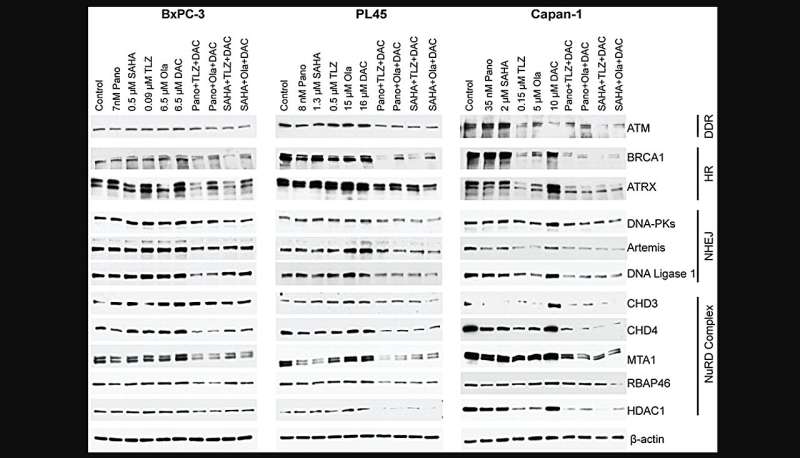This article has been reviewed according to Science X's editorial process and policies. Editors have highlighted the following attributes while ensuring the content's credibility:
fact-checked
peer-reviewed publication
proofread
Team reports on synergistic cytotoxicity of HDAC and PARP inhibitors and decitabine in pancreatic cancer cells

A new research paper titled "Synergistic cytotoxicity of histone deacetylase and poly-ADP ribose polymerase inhibitors and decitabine in pancreatic cancer cells: Implications for novel therapy" has been published in Oncotarget.
Histone deacetylase inhibitors (HDACi) can modulate the acetylation status of proteins, influencing the genomic instability exhibited by cancer cells. Poly (ADP ribose) polymerase (PARP) inhibitors (PARPi) have a direct effect on protein poly (ADP-ribosyl)ation, which is important for DNA repair. Decitabine is a nucleoside cytidine analog, which--when phosphorylated--gets incorporated into the growing DNA strand, inhibiting methylation and inducing DNA damage by inactivating and trapping DNA methyltransferase on the DNA, thereby activating transcriptionally silenced DNA loci.
In this new study, researchers Benigno C. Valdez, Apostolia M. Tsimberidou, Bin Yuan, Yago Nieto, Mehmet A. Baysal, Abhijit Chakraborty, Clark R. Andersen, and Borje S. Andersson from The University of Texas MD Anderson Cancer Center explored various combinations of HDACi and PARPi +/− decitabine (hypomethylating agent) in pancreatic cancer cell lines BxPC-3 and PL45 (wild-type BRCA1 and BRCA2) and Capan-1 (mutated BRCA2).
The researchers write, "[...] we explored various combinations of HDACis and PARPis, with or without decitabine, in pancreatic cancer cell lines."
The combination of HDACi (panobinostat or vorinostat) with PARPi (talazoparib or olaparib) resulted in synergistic cytotoxicity in all cell lines tested. The addition of decitabine further increased the synergistic cytotoxicity noted with HDACi and PARPi, triggering apoptosis (evidenced by increased cleavage of caspase 3 and PARP1).
The 3-drug combination treatments (vorinostat, talazoparib, and decitabine; vorinostat, olaparib, and decitabine; panobinostat, talazoparib, and decitabine; panobinostat, olaparib, and decitabine) induced more DNA damage (increased phosphorylation of histone 2AX) than the individual drugs and impaired the DNA repair pathways (decreased levels of ATM, BRCA1, and ATRX proteins). The 3-drug combinations also altered the epigenetic regulation of gene expression (NuRD complex subunits, reduced levels).
"This is the first study to demonstrate synergistic interactions between the aforementioned agents in pancreatic cancer cell lines and provides preclinical data to design individualized therapeutic approaches with the potential to improve pancreatic cancer treatment outcomes," the team notes.
More information: Benigno C. Valdez et al, Synergistic cytotoxicity of histone deacetylase and poly-ADP ribose polymerase inhibitors and decitabine in pancreatic cancer cells: Implications for novel therapy, Oncotarget (2024). DOI: 10.18632/oncotarget.28588


















